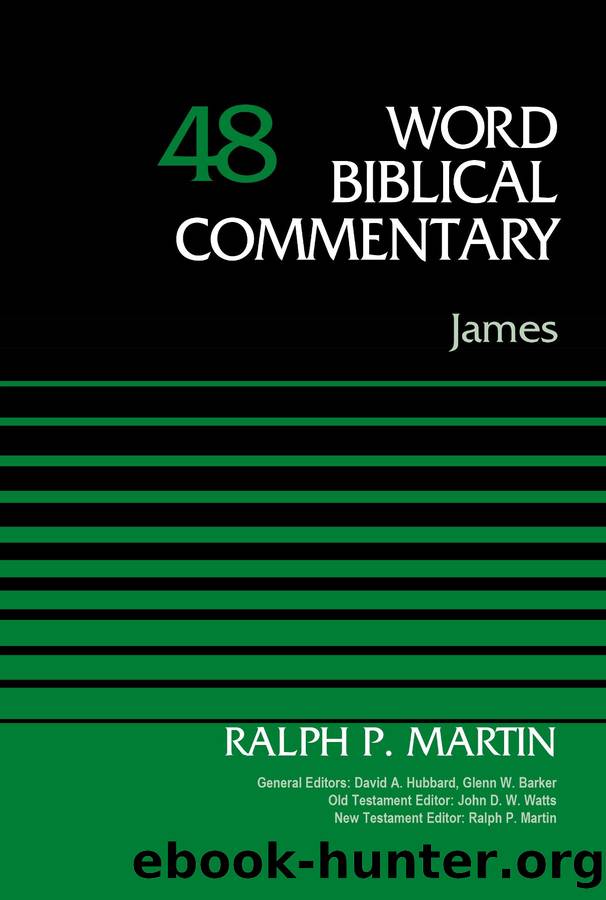James, Volume 48 by Ralph P. Martin;

Author:Ralph P. Martin; [Martin, Ralph P.]
Language: eng
Format: epub
Tags: REL006070 Religion / Biblical Commentary / New Testament
Publisher: HarperCollins Christian Publishing (3 users)
Notes
a. Reading Ïὸ á½Î¸ÎµÎ»Î¿Ï with the best witnesses. The omission of ÏÏ (B C* 102) is supported by Ropes, who regards the text of A as having been brought into conformity with 2:16, which has Ïὸ á½Î¸ÎµÎ»Î¿Ï: cf. 1 Cor 15:32, where also ÏÏ is omitted by D F G. The meaning is unaffected.
b. The punctuation is in dispute. Specifically, we cannot be sure where the objectorâs quotation ends. SeeForm/Structure/Setting.
c. This (reading ÏÏÏίÏ) is the text of Nestle-Aland26, supported by A B. There is a weaker yet well-attested alternative in the TR, á¼Îº Ïῶν á¼ÏγÏν ÏÎ¿Ï ; the vg has sine, which has produced the AV/KJV translations âwithoutâ in spite of the TRâs á¼Îº. Z. C. Hodges, âLight on James Two,â 345, wishes to defend the TR as the majority reading on the ground of its wide distribution and on the principle of lectio difficilior. R. W. Wall, âInterlocutor and James,â has reopened the debate, concluding that while the uncial support favors the critical reading, it does not do so decisively, and the issue of a correct reading must be decided on internal grounds, namely, that in order to account for the severity of the rebuke (in v 20: ὦ á¼Î½Î¸ÏÏÏε κενÎ) it is necessary to have the objector say more than the simple statement that there are two competing claims to authentic religion: You have faith, I have deeds (v 18a). For Wall, this is followed by an interlocutorâs second remark which is not tautological, that there are two beginning points of âtrue religionâ (1:27)âfaith and deedsâthat are ânot only mutually exclusive; they have no logical interplay as well.â The upshot of the objectorâs position is that âbelieversâ may choose to have either faith or works and still be classed as true to religion. Hence the parallelism á¼Îº Ïῶν á¼ÏγÏν . . . á¼Îº Ïῶν á¼ÏγÏν (accepting TR). The interlocutor also is responsible for the affirmation ÎºÎ±Î»á¿¶Ï Ïοιεá¿Ï, lit., âYou do well,â which he borrows from Jamesâ earlier remark (2:8, ÎºÎ±Î»á¿¶Ï Ïοιεá¿Ïε) about obedience to the royal law. He also cites the monotheistic formula as the epitome of his faith, seeking Jamesâ concurrence along with what he regards as the essence of faith. According to this reconstruction, based on the text-critical issue, Jamesâ reply begins in v 20 with a stinging invective. But it is still possible to claim that the flow of the discussion requires the interlocutorâs words to include more than v 18a, but to reject TRâs witness, which is weakly attested, as Ropes, 209, has shown.
Among translators the quotation marks usually close with v 18a, but Williams, The New Testament, offers an interesting exception. In the 1950 edition the quotation ends with v 18a, but this is changed in the 1986 edition to include the whole of the verse in the speakerâs discourse.
Vv 18â19b are a unit arranged in chiastic pattern (Donker, âDer Verfasser . . . sein Gegner,â 236; but overlooked by Burge, âAnd Threw Them Thusâ), and should not be split between separate speakers. This
Download
This site does not store any files on its server. We only index and link to content provided by other sites. Please contact the content providers to delete copyright contents if any and email us, we'll remove relevant links or contents immediately.
The Five People You Meet in Heaven by Mitch Albom(3336)
Real Sex by Lauren F. Winner(2867)
Name Book, The: Over 10,000 Names--Their Meanings, Origins, and Spiritual Significance by Astoria Dorothy(2840)
The Holy Spirit by Billy Graham(2777)
The Secret Power of Speaking God's Word by Joyce Meyer(2754)
ESV Study Bible by Crossway(2675)
How The Mind Works by Steven Pinker(2612)
0041152001443424520 .pdf by Unknown(2599)
Ancient Worlds by Michael Scott(2496)
The ESV Study Bible by Crossway Bibles(2421)
The Gnostic Gospels by Pagels Elaine(2399)
The Meaning of the Library by unknow(2386)
Churchill by Paul Johnson(2368)
MOSES THE EGYPTIAN by Jan Assmann(2277)
City of Stairs by Robert Jackson Bennett(2233)
Jesus by Paul Johnson(2229)
The Complete Dead Sea Scrolls in English (7th Edition) (Penguin Classics) by Geza Vermes(2139)
Ancient Near Eastern Thought and the Old Testament by John H. Walton(2131)
The Nativity by Geza Vermes(2115)
